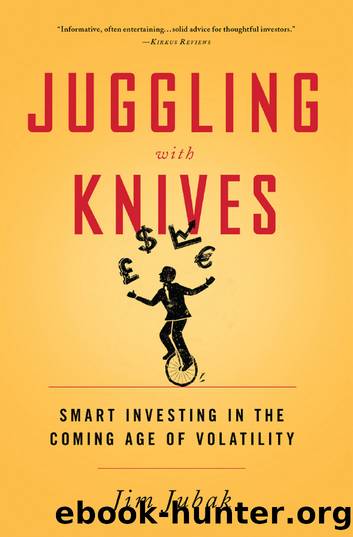Juggling with Knives: Smart Investing in the Coming Age of Volatility by Jim Jubak

Author:Jim Jubak [Jubak, Jim]
Language: eng
Format: azw3
ISBN: 9781610394819
Publisher: PublicAffairs
Published: 2016-01-25T16:00:00+00:00
Chapter 14
Volatility Trend No. 5
Real Estate Boom and Bust and the Volatility at the Extremes
WHAT OFTEN DRIVES VOLATILITY, as I argued in the chapter on education, isnât a significant change in the average result; rather, it is an increase in the probability that the result a single individual achieves will fall a significant distance either above or below that average. In real estate even more than in education what matters is the gain or loss at the extremes and the likelihood that your experience will wind up at an extreme.
Now that we can step back from the excitement of the real estate boom and the fear of the real estate bust, we can see that whole swaths of the real estate market werenât caught up in the cycle. There were indeed big bulges that represent extreme results, and those bulges drove our perception of volatility. But the results for many home owners in the middle were by no means as volatile.
Why? We need to be very careful in looking at what seems to be a uniform and unified market to see exactly where the causes of volatility begin and end. What we now know about the housing boom and bust is that the cycle wasnât something that sucked everyone in and that the results were sufficiently varied across the sector that there was the possibility of winning and losing strategies in response to the volatility. This would seem to suggest that in other cases of extreme volatility, including those that are still to come, itâs important to
â¢first understand what is causing the volatility,
â¢then map the power of those causes across the sector
â¢to see where those causes are operating and where they are now
â¢so you can devise strategies to take advantage of that volatility or find safe havens to stay away from it.
What matters most for our experience of the housing market over the next decade isnât the volatility of the averageâwhich is likely to change relatively slowly and relatively modestlyâbut instead the volatility at the extremes. The driver of housing-price volatility over the next decade or two will be determined less by the national median change of 11.5 percent in 2013 or the projected 2.1 percent national median annual change from 2015 to 2018 and more by the change in extremes at the fast-profits and big-losses ends of the barbell in places such as San Francisco and Nevada.
That doesnât mean, however, that we need to let that perception of volatility, drawn from our reaction to variation at the extremes, determine how we react to the actual volatility across a sector or market. Sometimes fear is just fear.
Which was the better real estate investment in the recent boom-bust-recovery cycle: Miami, Florida, or Elmira in upstate New York, located in whatâs called the Southern Tier, just a short distance from the Pennsylvania border and about 230 miles west of New York City?
No brainer, right? Well, no.
Elmiraâs golden age was the nineteenth century when the construction of canals and railroads put the city
Download
This site does not store any files on its server. We only index and link to content provided by other sites. Please contact the content providers to delete copyright contents if any and email us, we'll remove relevant links or contents immediately.
| Analysis & Strategy | Bonds |
| Commodities | Derivatives |
| Futures | Introduction |
| Mutual Funds | Online Trading |
| Options | Portfolio Management |
| Real Estate | Stocks |
Rich Dad Poor Dad by Robert T. Kiyosaki(6399)
Pioneering Portfolio Management by David F. Swensen(6226)
How To Win Friends and Influence People by Dale Carnegie(4441)
The Money Culture by Michael Lewis(4075)
The Dhandho Investor by Mohnish Pabrai(3698)
The Wisdom of Finance by Mihir Desai(3650)
Liar's Poker by Michael Lewis(3367)
Fooled by Randomness: The Hidden Role of Chance in Life and in the Markets by Nassim Nicholas Taleb(3043)
The ONE Thing by Gary Keller(3007)
The Intelligent Investor by Benjamin Graham Jason Zweig(2995)
Mastering Bitcoin: Programming the Open Blockchain by Andreas M. Antonopoulos(2980)
How to Day Trade for a Living: Tools, Tactics, Money Management, Discipline and Trading Psychology by Andrew Aziz(2909)
Rich Dad Poor Dad: What The Rich Teach Their Kids About Money - That The Poor And Middle Class Do Not! by Robert T. Kiyosaki(2907)
Investing For Dummies by Eric Tyson(2894)
How to Win Friends and Influence People by Dale Carnegie(2860)
Market Wizards by Jack D. Schwager(2643)
Zero Hour by Harry S. Dent Jr. & Andrew Pancholi(2614)
How to Pay Zero Taxes, 2018 by Jeff A. Schnepper(2592)
The Psychology of Money by Morgan Housel(2591)
